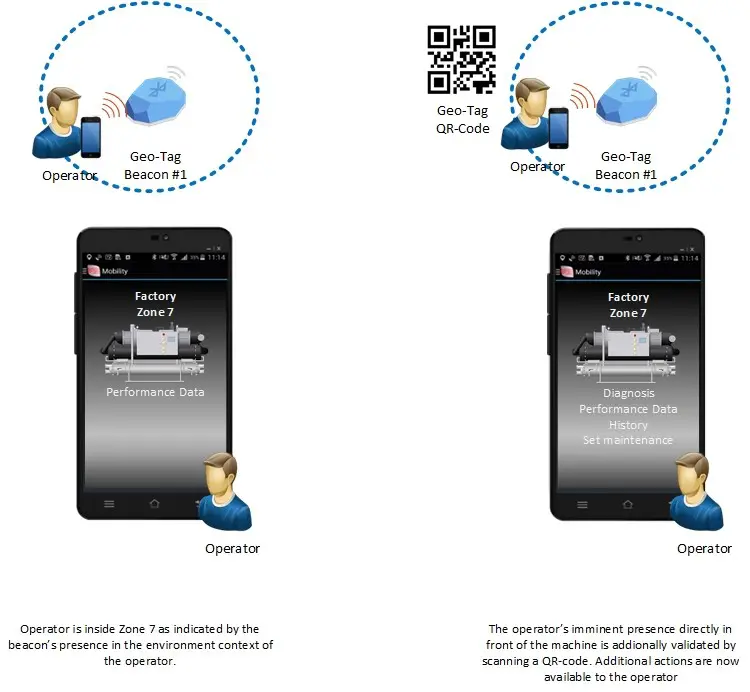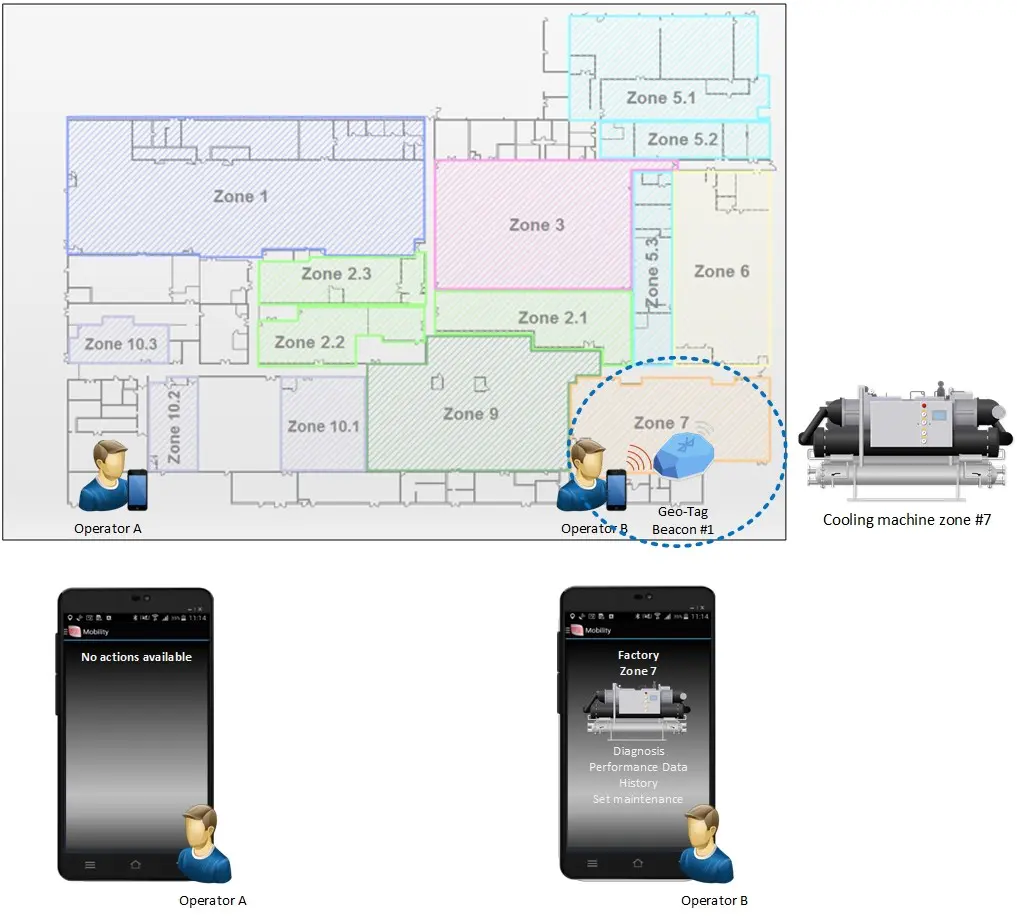
Securing the mobile device
Cyber security concerns are paramount in any information system and as in any network, it is important to provide a full range of security measures such as firewalls and active user rights management. Additional considerations must be thought through when deploying a mobility solution. Specific features within the framework of the mobility infrastructure include:
- User sign-on required to use the smart app
- Re-authenticate before control actions are performed
- Validation before critical actions are performed, including validating proximity of the user to the device with wearable sensor, such as a BLE beacon, and confirming validity via geo-tag attached to equipment, such as a QR code

Benefits to mobile users
A mobility infrastructure provides benefits for all users and to workers with certain responsibilities. The organization also derives benefits through greater safety, security, comfort, and efficiency.
Equipment management:
Operators can move out of the control room and work more closely with the systems they manage. This is possible with the ability to view key characteristics, which are refreshed as they move. The system continues to maintain awareness and receive alarms across all zones. Trends may be viewed, set points changed, and any other operator actions performed. When out of the zone of operational responsibility, the operator’s rights may allow viewing operations without access to control of those particular assets.
Maintenance:
The mobility server is aware of the location of remote maintenance personnel and can intelligently dispatch alarms to the person best positioned to respond. Proximity rules enable innovative thinking about organizing a maintenance strategy. New ways to combine proactive and reactive aspects of maintenance based on a real-time assessment of resources and proximity are possible.
In a recent study by Fraunhofer USA, the benefits of mobility were explored with industry experts who specify and design building management systems (BMS) and EMS systems. What emerged was that supervisory systems could be a double-edged sword for maintenance workers. The information needed for maintenance is in the system, but it can be difficult to access, and it can be difficult to understand, given the format of the information. The promise of mobility to proactively deliver the needed information in an understandable format and to guide the maintenance worker to solve the problem was identified as a major benefit.
As maintenance workers move, they are provided updated contextual tools. These tools are in the context of the physical orientation (nearby, lift equipment zone, full facility, etc.) and provide the most useful tools for that user based on training and certifications.
For example, a maintenance engineer may be monitoring an asset that is suspected or known to have malfunctioned. The component has uniquely identified its location determined by one or more geo-tags. When approaching the geo-tags the proximity services app synchronizes with the mobility server, which responds with contextual information and control actions. The information and control actions related to nearby assets include (as shown in Figure 5):
- Access to real-time and historical information
- Display of the trend for any variable of interest
- Access to the asset’s alarm list
- Ability to put the asset into maintenance mode
- Access to technical documentation for the asset.
Commissioning:
Commissioning can be labor intensive and time consuming. Typically one worker located at the control room uses a radio to communicate with a field worker to relay the status of the equipment. A participant in the Fraunhofer report noted, “I don’t need two people to do something one can now do.” The mobile worker is provided with an HMI for operating the equipment and access to resources, such as commissioning checklists, electrical diagrams, and start-up procedures, automatically delivered to the mobile device as the worker approaches the equipment.

Access control:
The mobility server knowledge of workers’ credentials and current location provides the baseline for access control. When a facility visitor requires access to a zone, the request is known to the mobility server based on the person’s proximity to a geo-tag associated to the access point. The mobility server may grant access and verify that the user has entered the zone.
Geo-fencing refers to the management of user rights as they move through different zones. The mobility server enforces the geo-fences. Worker rights are allowed to change depending on the current zone. An alarm may be raised when persons are entering or leaving a zone (crossing the virtual fence) without prior authorization.
Safe movement:
The mobility infrastructure also supports life safety. It can coordinate and monitor the progress of any required evacuations including providing information about the best route given the real-time situation. The mobility server can monitor workers remaining in danger zones and alert workers moving in an unsafe direction. Safety-related warnings can be directed to the mobility user, and that person will now be accounted for in the case of an emergency.
Benefits to operations
The aggregate view of mobile personnel and movable assets is extremely valuable for managing resources.
User movement history:
Tracking changes of location over time is an extension of the proximity services. By monitoring the real-time location of the worker, traffic analysis such as the density of workers in an area, can be visualized in real-time and displayed on 2D or 3D maps. According to the designers who participated in the Fraunhofer study, this is the future of the industry. This is particularly true in high-value facilities, such as multi-use buildings, hospitals, labs, vivarium, and facilities and campuses with large central plants or chillers.
Actions of the mobility server as a result of tracking asset location include:
- Raising a security alarm
- Adjust environmental controls for temperature, lighting, etc.
- Perform energy balancing.
Asset tracking:
Geo-tags associated with assets are registered in the mobility server. The relationship with the position of the asset geo-tag compared to stationary geo-tags associated with zones makes it possible to track mobile assets inside a facility. As in previously described cases, the mobility server may react to the repositioning of a moving asset via alarming, visualization, or recording (archiving).
Smarter monitoring, control
The rise of smart mobile devices that are now familiar to almost all workers has created an opportunity to improve mobility for monitoring and control. This trend moves away from managing from a central control room to a distributed model of personnel on-the-move. The way in which users interact with their mobile device compared to how an operator works in a control room requires a mobility infrastructure to optimize efficiency, safety, and security.
With the standardization of geo-location and micro geo-location capability on mobile devices it is possible to monitor mobile personnel location and drive contextual information and controls to their smart device based on their credentials and location without requiring specialized equipment.
The mobility infrastructure results from the desire to use the rapid growth and availability of smartphones and tablets. Incorporating proximity services with a mobile app and mobile server enables world-class mobility solutions for supervisory control and data acquisition (SCADA) and building management system (BMS) projects.
Edward Nugent is the chief operating officer of PcVue Inc. of Woburn, Mass., Edited by Emily Guenther, associate content manager, CFE Media, Control Engineering, eguenther@cfemedia.com.
http://www.controleng.com/single-article/contextual-mobility-for-monitoring-and-control/ec525638d5b41cb5a4f0e19ec8fc8d96.html?tx_ttnews[sViewPointer]=1
Created on: 23 May 2017






